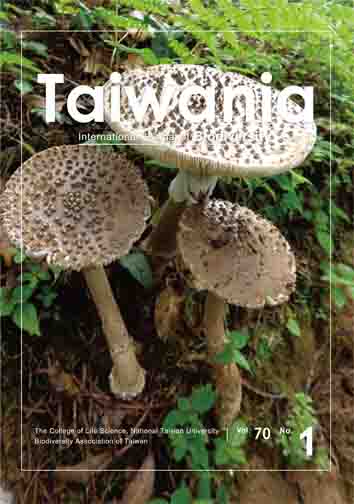Research Paper
Characteristics and dynamics of Alnus nepalensis dominated forests in the subtropical region of Yunnan, southwestern China
Cindy Q. Tang, Qiao Li, Kang-Di Pei, Shu-Li Xiao, Qing Chen, Shuifeng Li, You-Cai Shi, Peng-Bin Han, Jia-Le Zeng, Ming-Chun Peng, Chong-Yun Wang
Published on: 21 February 2025
Page: 176 - 185
DOI: 10.6165/tai.2025.70.176
Abstract
Alnus nepalensis is a deciduous broad-leaved tree species. It commonly appears in patchy distributions following the destruction of evergreen broad-leaved forests or the abandonment of agricultural land in the subtropical region of Yunnan, southwestern China. This versatile and ecologically important tree species plays a crucial role in the environment. Studying its community characteristics and succession trends is vital for understanding diverse forest types and secondary succession in the subtropical areas. Through our field vegetation investigation, we identified six forest types, i.e., 1: Alnus nepalensis deciduous broad-leaved forest; 2: Alnus nepalensis-Schima wallichii deciduous and evergreen broad-leaved mixed forest; 3: Alnus nepalensis-Pinus armandii deciduous broad-leaved and evergreen coniferous mixed forest. 4: Alnus nepalensis-Litsea monopetala deciduous and evergreen broad-leaved mixed forest. 5: Alnus nepalensis-Quercus aliena-Pinus yunnanensis deciduous broad-leaved and evergreen coniferous mixed forest. 6: Alnus nepalensis-Quercus delavayi deciduous and evergreen broad-leaved mixed forest. Among the six forest types, the Shannon-Wiener diversity ranged from 1.1 to 2.1. In all the forest types, A. nepalensis trees were predominantly found in DBHs of 10-30 cm with ages of ca. 10-30 years. Its maximum age reached ca. 95 years with a DBH of 132 cm. In central Yunnan, the successional pathways: transitioning from Alnus nepalensis-Quercus aliena- Pinus yunnanensis deciduous broad-leaved or evergreen coniferous mixed forest, Alnus nepalensis-Pinus yunnanensis-Quercus aliena mixed forest, or Alnus nepalensis deciduous broad-leaved forest, gradually shifting to Alnus nepalensis-Quercus delavayi deciduous and evergreen broad-leaved mixed forest, and ultimately progressing to Quercus delavayi evergreen broad-leaved forest.
Keyword: Forest types, forest structure, species diversity, population structure, secondary succession
Literature Cited
Arroyo-Rodr?guez, V, Melo, F., Miguel, M.-R., M., Bongers, F., Chazdon, R.L., Meave, J.A., Norden N, Santos, B.A., Leal. I., Tabarelli, M. 2017 Multiple successional pathways in human?modified tropical landscapes: new insights from forest succession, forest fragmentation and landscape ecology research. Biol. Rev. 92(1): 326–340.
DOI: 10.1111/brv.12231View Article
Google Scholar
Balami, S., Va?utov?, M., Chaudhary, V.K., Cudl?n, P. 2023 How do root fungi of Alnus nepalensis and Schima wallichii recover during succession of abandoned land? Mycorrhiza 33(5-6): 321–332.
DOI: 10.1007/s00572-023-01124-6View Article
Google Scholar
Chen, L.Z., Chen, Q.L., Liu, W.H. 1995 Studies on Biodiversity: Diversity and Geographical Distribution of Forests in China. Science Press, Beijing (in Chinese). https://doi.org/10.1007/978-94-017-9741-2.
Joshi, R.K. and Garkoti, S.C. 2020 Litter dynamics, leaf area index and forest oor respiration as indicators for understanding the role of Nepalese alder in white oak forests in central Himalaya, India. Ecol. Indic. 111: 106065.
DOI: 10.1016/j.ecolind.2020.106065View Article
Google Scholar
Kurkowski, T.A., Mann, D.H., Rupp, T.S., Verbyla, D.L. 2008 Relative importance of different secondary successional pathways in an Alaskan boreal forest. Can. J. For. Res., 38(7): 1911–1923.
DOI: 10.1139/X08-039View Article
Google Scholar
Lande, R. 1996 Statistics and partitioning of species diversity, and similarity among multiple communities. Oikos 76(1): 5–13.
DOI: 10.2307/3545743View Article
Google Scholar
Li, D.W., Chen, H.W., Shi, F.Q., Yang, B., Li, J. 2008 Ecological characteristics and geographical distribution of Alnus nepalensis in Yunnan. Forestry Inventory and Planning 33(5): 25–28 (in Chinese).
Li, M.P., Miao, N., Liu, S.R. 2022 Effects of nitrogen-fixing tree species Alnus nepalensis on the degraded soils and understory restoration in the upper reaches of the Jinsha River, China. Acta Ecol. Sin. 42(6): 2321–2330 (in Chinese).
DOI: 10.5846/stxb202101120121View Article
Google Scholar
Li, W.J., Tang, Z.M., Zhu, C.L., Xu, B. 1999 Study of Dai medicine Alnus nepalensis. Journal of Traditional Chinese Medicine of Yunnan 20(04): 23–24.
McCune, B., Mefford, M.J. 2016 PC-ORD: multivariate analysis of ecological data, version 7.0 for Windows. Wild Blueberry Media, Corvallis, Oregon, USA.
Molles, M. 2016 Ecology: Concepts and applications. Seventh editions. New York (USA): McGraw Hill Education.
Oliver, E.E., Houlton, B.Z., Lipson, D.A. 2021 Controls on soil microbial carbon use efficiency over long-term ecosystem development. Biogeochemistry 152(2-3): 309–325.
DOI: 10.1007/s10533-021-00758-yView Article
Google Scholar
Pielou, E.C. 1969 An Introduction to Mathematical Ecology. Wiley, New York.
Sharma, E., Sharma, R., Pradhan, M. 1998 Ecology of Himalayan alder (Alnus nepalensis D. Don). PINSA, B64, 5978.
Singh, S.P. 2014 Attributes of Himalayan forest ecosystems: they are not temperate forests. Proc. Indian Natn. Sci. Acad. 80(2): 221–233.
DOI: 10.16943/ptinsa/2014/v80i2/55103View Article
Google Scholar
Sullivan, B.W, Nifong, R.L., Nasto, M.K., Alvarez-Clare, S., Dencker, C.M., Soper, F.M., Shoemaker, K.T., Ishida, F.Y., Zaragoza-Castells, J., Davidson, E.A., Cleveland, C.C. 2019 Biogeochemical recuperation of lowland tropical forest during succession. Ecology 100(4): e02641.
DOI: 10.1002/ecy.2641View Article
Google Scholar
Sun, H., Zhou, Z.-K., Yu, H.-Y. 1996 A preliminary probe into the secondary succession series of tropical forests in the big ben gorge of Yalu Tsangpo River in S. E. Tibet, E. Himalayas. Acta Bot. Yunnan. 18(3): 308–316 (in Chinese).
Storrs, A., Storrs, J. 1984 Discovering trees in Nepal and the Himalayas. Sahayogi Press, Kathmandu, Nepal.
Tang, C.Q. 2015 The Subtropical Vegetation of Southwestern China: Plant Distribution, Diversity and Ecology. Plants and Vegetation vol. 11. Springer, Dordrecht.
DOI: 10.1007/978-94-017-9741-2_1View Article
Google Scholar
Tang, C.Q., Han, P.B., Wen, J.R., Lu, X., Yao, S.-Q., Du, M.-R., Zhu, M.-Y. 2024 Species diversity patterns in the subtropical forests of southeastern Yunnan, China. In: Claude, J., Kitana, N. (eds), On the edge of the sixth mass extinction in biodiversity hotspots: Facts, needs, solutions and opportunities in Thailand and adjacent countries. Chulalongkorn University, Phayathai Road, Bangkok 10330, Thailand.
Tang, C.Q., He, L.-Y., Su, W.-H., Zhang, G.-F., Wang, H.-C., Peng, M.-C., Wu, Z.-L., Wang, C.-Y. 2013 Regeneration, recovery and succession of a Pinus yunnanensis community five years after a mega-fire in central Yunnan, China. For. Ecol. Manag. 294: 188–196;
DOI: 10.1016/j.foreco.2012.07.019View Article
Google Scholar
Tang, C.Q., Lu, X., Du, M.-R., Xiao, S.-L., Li, S., Han, P.-B., Zeng, J.-L., Wen, J.-R., Yao, S.-Q., Shi, Y.-C., Li, Y.-F., Peng, M.-C., Wang, C.-Y., Zhang, Z.-Y. 2022 Forest characteristics and population structure of a threatened palm tree Caryota obtusa in the karst forest ecosystem of Yunnan, China. J. Plant Ecol. 15(4): 829–843.
DOI: 10.1093/jpe/rtab117View Article
Google Scholar
Tang, C.Q., Zhao, M.H., Li, X.S., Ohsawa, M., Ou, X.K. 2010 Secondary succession of plant communities in a subtropical mountainous region of SW China. Ecol. Res. 25(1): 149–161.
DOI: 10.1007/s11284-009-0644-zView Article
Google Scholar
Varghese, R., Chauhan, V.S., Misra, A.K. 2003 Evolutionary implications of nucleotide sequence relatedness between Alnus nepalensis and Alnus glutinosa and also between corresponding Frankia micro symbionts. Plant Soil 254(1): 219–227.
DOI: 10.1023/A:1024963215959View Article
Google Scholar
Walker, L.R., Wardle, D.A. 2014 Plant succession as an integrator of contrasting ecological time scales. Trends Ecol. Evol. 29(9): 504–510.
DOI: 10.1016/j.tree.2014.07.002View Article
Google Scholar
Wang, K., Wang, X.X., Fei, H.Y., Wan, C.Y., Han, F.P. 2022 Changes in diversity, composition and assembly processes of soil microbial communities during Robinia pseudoacacia L. restoration on the Loess Plateau, China. J. Arid Land 14(5): 561–575.
DOI: 10.1007/s40333-022-0064-2View Article
Google Scholar
Winrock International 2024 Alnus nepalensis – A Multipurpose Tree for the Tropical Highlands. Available website: https://winrock.org/alnus-nepalensis-a-multipurpose-tree-for-the-tropical-highlands/.
Wu, Z.-Y. 1991 The areal-types of Chinese genera of seed plants. Plant Divers. 13(S4): 1–139 (in Chinese).
Wu, Z.-Y. 2003 The areal- types of the world families of seed plants. Revised version. Acta Bot. Yunn. 5: 535–538 (in Chinese).
Xia, C., Zhao,W.,Wang, J., Sun, J., Cui, G., Zhang, L. 2023 Progress on geographical distribution, driving factors and dcological functions of Nepalese Alder. Diversity 15(1): 59.
DOI: 10.3390/d15010059View Article
Google Scholar
Zhong, Z.K., Li, W.J., Lu, X.Q., Gu, Y.Q., Wu, S.J., Shen, Z.Y., Han, X.H., Yang, G.H., Ren, C. J. 2020 Adaptive pathways of soil microorganisms to stoichiometric imbalances regulate microbial respiration following afforestation in the Loess Plateau, China. Soil Biol. Biochem. 151: 108048.
DOI: 10.1016/j.soilbio.2020.108048View Article
Google Scholar
Zhou, G.L., Yang, C.H. 1988 Alnus nepalensis. Forestry and Technology of Guizhou 1(1): 93–95.


